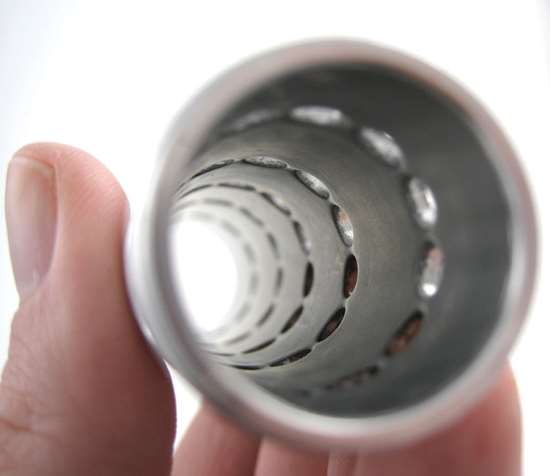Diverse Applications for Ball-Style Honing
A ball-style hone is a specialized abrasive tool that is characterized by small, abrasive globules that are permanently mounted to flexible filaments. It is designed to be a low-cost tool for sophisticated surfacing, deburring and edge blending.
A ball-style hone is a specialized abrasive tool that is characterized by small, abrasive globules that are permanently mounted to flexible filaments. It is designed to be a low-cost tool for sophisticated surfacing, deburring and edge blending.
The Flex-Hone tool, from Brush Research Manufacturing Co. (BRM), was originally designed for cylinder finishing, deburring and deglazing. It has also proven effective for other applications that call for the use of a resilient, flexible and soft-cutting honing solution. The independently suspended, abrasive globules both self-center and self-align to the bore and self-compensate for wear, all of which facilitate close-tolerance finishing work.
Featured Content
The applications for which the ball-style hone is suitable range from very simple operations, such as in the hosel hole of the head of a golf club to provide a coarser finish for adhesive bonding when re-shafting, to the complex finishing jobs common to machining and manufacturing. This versatility stems, in part, from the fact that the product is available with a range of abrasives and grits. BRM custom designs ball-style hones to meet the specifications of customers for a number of applications. They are available in diamond abrasive for cutting harder materials such as carbide. Levigated alumina is being used in larger diameters for super fine finishes on high performance piston rings. The Flex-Hone for firearms has custom and standard shaped hones for barrels, chambers, and forcing cones in different grit selections.
Surface Finishing
The Flex-Hone tool is available in a variety of abrasive types and grit selections to provide the optimum surface finish on any base material. It is commonly used to reduce Ra, Rk and Rpk values while maintaining Rvk and Vo volume for oil retention. Using the tool for surface finishing allows the sizing tools to do their jobs quickly and accurately without fighting surface finish. The tool is also used in adhesive bonding applications where a rougher surface is desired for bonding integrity.
Deburring
Deburring of cross-drilled holes is an expensive, time-consuming operation. The Flex-Hone tool can be used to remove burrs from cross-drilled holes, leaving a clean, radiused intersection. Because of its unique construction, the tool can be used online in machine tool applications or offline as a secondary operation. The tool is self-centering and self-aligning to the bore, so elaborate, rigid setups are not required. It is advisable to use the tool in the main bore into which the cross holes break. Best results are obtained by rotating and stroking the tool a few strokes in a clockwise direction, removing the tool from the part, reversing the spindle and then rotating and stroking the tool in a counter clockwise direction for a few more strokes. This forward and reverse rotation creates a more symmetrical deburring pattern.
Plateau Finishing
BRM is a strong proponent of the benefits of a cross hatch, plateaued finish. The concept involves removing the peaks produced by prior machining operations and creating a substantially flat or plateau finish. A plateau finish created by the elimination of peaks allows rings and seals to seat without damaging their edges. The cross hatch pattern will aid in lubrication control and retention, reduce seepage in hydraulic and pneumatic applications and promote longer seal life.
Picking the right honing tool depends a lot on the application. Important selection factors include the size of the tool, the type of abrasive used and the grit/grade. Honing tools from BRM are available in sizes to finish bore diameters from 4 mm to 36 inches. Available abrasive types include silicon carbide, aluminum oxide, boron carbide, tungsten carbide, levigated alumina and zirconia-alumina. All abrasives are produced in a range of grit sizes, from very coarse (20) to as fine as 800. Tools can be easily customized for tapered and multi-diameter bores.
.png;maxWidth=970;quality=90)








